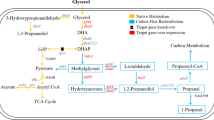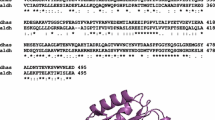Abstract
Recombinant Klebsiella pneumoniae over-expressing 3-hydroxypropionaldehyde (3-HPA) dehydrogenase can produce 3-hydroxypropionic acid (3-HP), an important platform chemical, from glycerol. However, K. pneumoniae co-produces 1,3-propanediol (1,3-PDO) due to the presence of 1,3-propanediol oxidoreductases, which decreases the titer and yield of 3-HP. Previously, two major oxidoreductases, dhaT and yqhD, were removed from K. pneumoniae; however the mutant still produced a significant amount of 1,3-PDO, indicating the probable existence of other oxidoreductase(s). Genome analysis of K. pneumoniae revealed the presence of five putative oxidoreductases having high amino acid similarities to both DhaT (primary 1,3-propanediol oxidoreductase) and YqhD (aldehyde dehydrogenase). Among them, adhE was highly expressed in the absence of DhaT and YqhD. Additionally, an alkyl hydroperoxide oxidoreductase (ahpF), albeit dissimilar to both DhaT and YqhD, was highly expressed in the absence of DhaT and YqhD. To examine the role of adhE and ahpF in 1,3-PDO production, mutant strains devoid of dhaT, yqhD, ahpF and/or adhE genes were developed. However, these mutants neither reduced the production of 1,3-PDO nor improved the production of 3-HP when engineered to over-express an aldehyde dehydrogenase (KGSADH). These results indicate that, apart from DhaT, YqhD, AhpF and AdhE, K. pneumoniae has other, unknown oxidoreductases that are involved in 1,3-PDO production. It is concluded that complete elimination of 1,3-PDO during 3-HP production from glycerol by K. pneumoniae is highly challenging.
Similar content being viewed by others
References
Wang, Z., Z. Wu, and T. Tan (2013) Studies on purification of 1, 3-propanediol by molecular distillation. Biotechnol. Bioproc. Eng., 18: 697–702.
Gokarn, R. R., O. V. Selifonova, H. J. Jessen, S. J. Gort, T. Selmer, and W. Buckel (2007) 3-Hydroxypropionic acid and other organic compounds. US Patent 7,186,541B2.
Werpy, T. and G. Petersen (2004) Top value added chemicals from biomass, volume 1: Results of screening for potential candidates from sugars and synthesis gas. US Department of Energy. [http://www.osti.gov/bridge].
Sankaranarayanan, M., S. Ashok, and S. Park (2014) Production of 3-hydroxypropionic acid from glycerol by acid tolerant Escherichia coli. J. Ind. Microbiol. Biotechnol., 41: 1039–1050.
Rathnasingh, C., S. M. Raj, J. E. Jo, and S. Park (2009) Development and evaluation of efficient recombinant Escherichia coli strains for the production of 3-hydroxypropionic acid from glycerol. Biotechnol. Bioeng., 104: 729–739.
Arasu, M. V., R. Sarkar, B. S. Sekar, V. Kumar, C. Rathnasingh, H. Song, D. Seung, and S. Park (2013) Isolation of a novel Pseudomonas species SP2 producing vitamin B12 under aerobic condition. Biotechnol. Bioproc. Eng., 18: 43–51.
Ashok, S., S. Mohan Raj, Y. Ko, M. Sankaranarayanan, S. Zhou, V. Kumar, and S. Park (2013) Effect of puuC overexpression and nitrate addition on glycerol metabolism and anaerobic 3-hydroxypropionic acid production in recombinant Klebsiella pneumoniae ΔglpKΔdhaT. Metab. Eng., 15: 10–24.
Huang, Y., Z. Li, K. Shimizu, and Q. Ye (2013) Co-production of 3-hydroxypropionic acid and 1,3-propanediol by Klebseilla pneumoniae expressing aldH under microaerobic conditions. Bioresour. Technol., 128: 505–512.
Ashok, S., S. M. Raj, C. Rathnasingh, and S. Park (2011) Development of recombinant Klebsiella pneumoniae ΔdhaT strain for the co-production of 3-hydroxypropionic acid and 1,3-propanediol from glycerol. Appl. Microbiol. Biotechnol., 90: 1253–1265.
Huang, Y., Z. Li, K. Shimizu, and Q. Ye (2012) Simultaneous production of 3-hydroxypropionic acid and 1,3-propanediol from glycerol by a recombinant strain of Klebsiella pneumoniae. Bioresour. Technol., 103: 351–359.
Ko, Y., S. Ashok, S. Zhou, V. Kumar, and S. Park (2012) Aldehyde dehydrogenase activity is important to the production of 3-hydroxypropionic acid from glycerol by recombinant Klebsiella pneumoniae. Proc. Biochem., 47: 1135–1143.
Jarboe, L. R. (2011) YqhD: A broad-substrate range aldehyde reductase with various applications in production of biorenewable fuels and chemicals. Appl. Microbiol. Biotechnol., 89: 249–257.
Ashok, S., M. Sankaranarayanan, Y. Ko, K. E. Jae, S. K. Ainala, V. Kumar, and S. Park (2013) Production of 3-hydroxypropionic acid from glycerol by recombinant Klebsiella pneumoniae ΔdhaTΔyqhD which can produce vitamin B12 naturally. Biotechnol. Bioeng., 110: 511–524.
Hall, R. H. and E. S. Stern (1950) Acid-catalysed hydration of acrylaldehyde: Kinetics of the reaction and isolation of b-hydroxypropaldehyde. J. Chem. Soc. 490–498.]
Laemmli, U. K. (1970) Cleavage of structural proteins during the assembly of the head of bacteriophage T4. JNature, 227: 680–685.
Yim, S. H., T. M. Kim, H. J. Hu, J. H. Kim, B. J. Kim, J. Y. Lee, B. G. Han, S. H. Shin, S. H. Jung, and Y. J. Chung (2010) Copy number variations in East-Asian population and their evolutionary and functional implications. Hum. Mol. Genet., 19: 1001–1008.
Link, A. J., D. Phillips, and G. M. Church (1997) Methods for generating precise deletions and insertions in the genome of wild-type Escherichia coli: Application to open reading frame characterization. J. Bacteriol., 179: 6228–6237.
Bradford, M. M. (1976) A rapid and sensitive method for the quantitation of microgram quantities of protein utilizing the principle of protein-dye binding. Anal. Biochem., 72: 248–254.
Raj, S. M., C. Rathnasingh, J.-E. Jo, and S. Park (2008) Production of 3-hydroxypropionic acid from glycerol by a novel recombinant Escherichia coli BL21 strain. Proc. Biochem., 43: 1440–1446.
Johnson, E. A. and E. C. Lin (1987) Klebsiella pneumoniae 1,3-propanediol:NAD+ oxidoreductase. J. Bacteriol., 169: 2050–2054.
Wang, W., J. Sun, M. Hartlep, W. D. Deckwer, and A. P. Zeng (2003) Combined use of proteomic analysis and enzyme activity assays for metabolic pathway analysis of glycerol fermentation by Klebsiella pneumoniae. Biotechnol. Bioeng., 83: 525–536.
Li Calzi, and L. B. Poole (1997) Requirement for the two AhpF cystine disulfide centers in catalysis of peroxide reduction by alkyl hydroperoxide reductase. Biochem., 36: 13357–13364.
Kim, H. J., B. K. Hou, S. G. Lee, J. S. Kim, D. W. Lee, and S. J. Lee (2013) Genome-wide analysis of redox reactions reveals metabolic engineering targets for D-lactate overproduction in Escherichia coli. Metab. Eng., 18: 44–52.
Arasu, M., V. Kumar, S. Ashok, H. Song, C. Rathnasingh, H. Lee, D. Seung, and S. Park (2011) Isolation and characterization of the new Klebsiella pneumoniae J2B strain showing improved growth characteristics with reduced lipopolysaccharide formation. Biotechnol. Bioproc. Eng., 16: 1134–1143.
Author information
Authors and Affiliations
Corresponding author
Rights and permissions
About this article
Cite this article
Ko, Y., Ashok, S., Seol, E. et al. Deletion of putative oxidoreductases from Klebsiella pneumoniae J2B could reduce 1,3-propanediol during the production of 3-hydroxypropionic acid from glycerol. Biotechnol Bioproc E 20, 834–843 (2015). https://doi.org/10.1007/s12257-015-0166-1
Received:
Revised:
Accepted:
Published:
Issue Date:
DOI: https://doi.org/10.1007/s12257-015-0166-1




